Arts | My Neighborhood: Pilsen
Arts
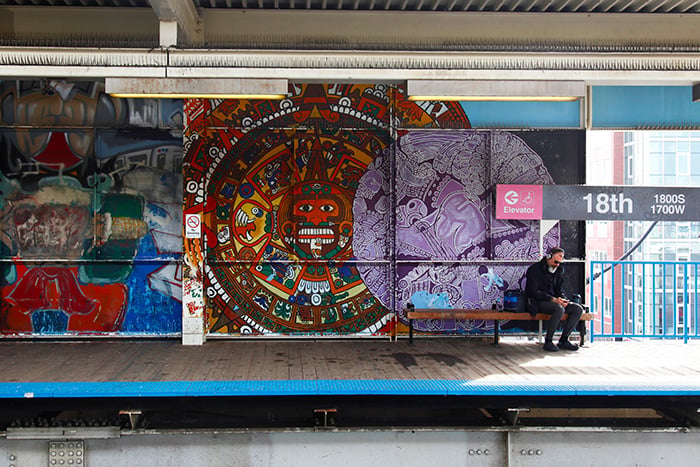
A commuter waits on the train on the 18th Street Pink Line platform. Photo by Kaitlynn Scannell
Pilsen’s public art has long been highly revered and highly politicized. It is a vehicle for celebrating its residents’ minority culture, instilling ethnic pride, and claiming space. It is a means of celebrating life itself, an affront to the dignity-sapping effects of racism, exclusion, and poverty. In recent decades, it has also become an asset, attracting new residents, businesses, and investors, even as Pilsen becomes a place where many artists can no longer afford to live and work.
Still, for decades, Pilsen’s artwork, splashed along its walls and viaducts, has delineated the neighborhood as a center not only of Mexican culture, but also of political engagement and self-expression.
It began in the late 1960s. Early artists wanted to unify, inspire, and educate the residents of Pilsen as the Mexican greats – including Diego Rivera, José Clemente Orozco, and David Alfaro Siqueiros -- did for their paisanos, or countrymen, in the mid-twentieth century. In short, it was a desire not to “leave Mexico behind, [but to bring] Mexico with us,” as expressed by National Museum of Mexican Art tour guide Gilberto Sandoval in My Neighborhood: Pilsen.
The late 1960s and early ’70s were also a time when many Mexicans and Mexican-Americans had just arrived in Pilsen and were being met with overt racism by many of the Polish and Bohemian residents who had called Pilsen their home for generations. Part of the impetus for the burgeoning mural scene at that time was to claim space for the growing Chicano power movement, to mark territory, and to do it with pride.
Century-old buildings constructed by white ethnics generations prior were reimagined and reclaimed. Howell House became Casa Aztlán and a monument to Mexican pride after Ray Patlan, who had been teaching arts workshops there, adorned the exterior with images of Mexican heroes from Benito Juarez to Cesar Chavez in the late ‘60s. The building soon became home to such artists as Marcos Raya and Aurelio Diaz, who extended their canvas onto buildings and viaducts all the way to Western and 16th Street.
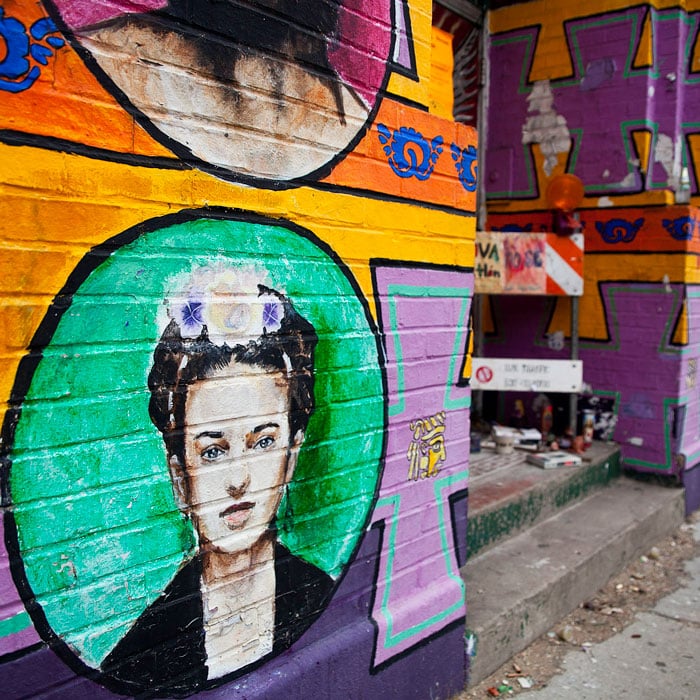
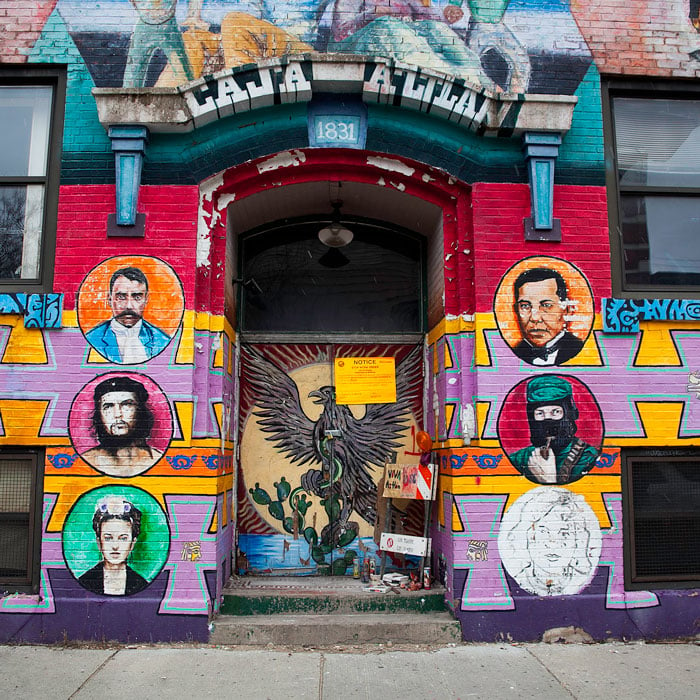
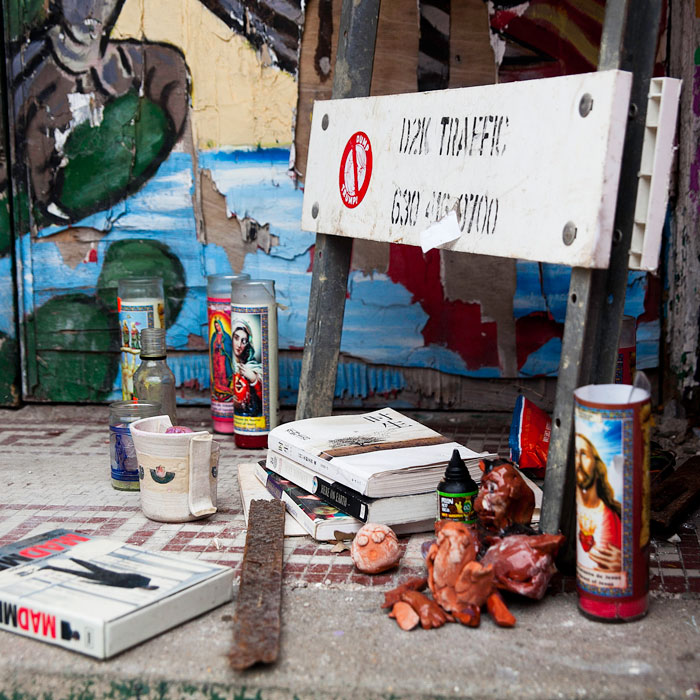
Casa Aztlán today stands vacant on the 1800 block of South Racine. Photo by Kaitlynn Scannell
In 1982, Humberto Salinas, then-director of Casa Aztlán , said the purpose of the murals was to enrich the lives of the citizens, ease the transition of the newcomer, and give the younger generation “a sense of their own identities” so that they might carry it forward to succeeding generations.
The influx of arts and creativity wasn’t just for painters. Chicano street theater troupes, such as Compania Trucha and Teatro del Barrio, added to the political and cultural discourse with humorous and thought-provoking performances at schools, on the streets and at bars and other gathering spaces. Musicians, poets, sculptors, and other artists have made strong contributions to the vibrancy and rich cultural identity of the neighborhood.
In 1978, artists created a formal avenue for seasoned artists to mentor young people through ElevArte, based at St. Procopius School. Today, the organization continues to offer after-school and summer programs for teens, as well as an enormous annual Day of the Dead community procession.

Aurelio Diaz created Galeria del Barrio in 1976; in 2016, Sam Kirk restored it with the support of the Chicago Public Art Group. Photo by Kaitlynn Scannell
Some artists found ways to bring their work into the schools. Francisco Mendoza, who taught for 25 years at Cooper Upper Grade Center, later renamed Orozco Elementary, used the exterior walls of the school to both teach students mosaics and celebrate Latin American history.
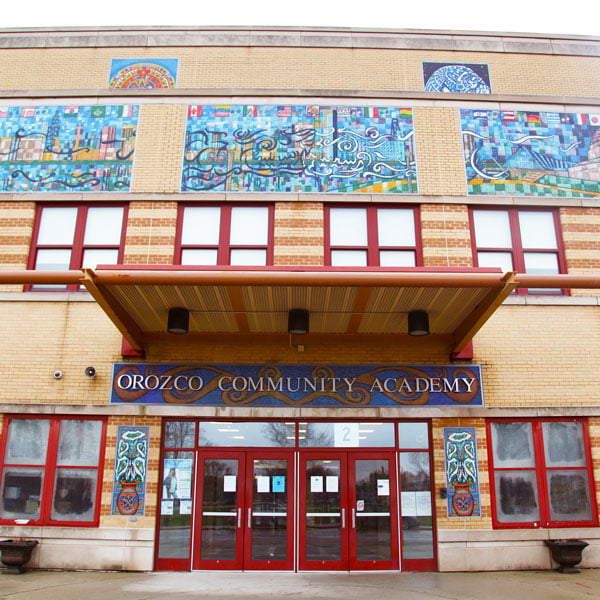
Front of Orozco Community Academy. Photo by Kaitlynn Scannell
In 1982, Carlos Tortolero and a group of community arts educators founded the Mexican Fine Arts Center Museum (now the National Museum of Mexican Art). It opened its doors in 1987, later expanding to a new facility in Harrison Park in East Pilsen in 2001. In 1997, they added a youth program, Yollocalli Arts Reach.
In 2009, longtime Pilsen resident and celebrated muralist Jeff Maldonado created the J-Def Peace Project, a youth arts program dedicated to the memory of his son. Through the project, teens have added their own messages of hope, non-violence, and empowerment to the rich anthology of Pilsen’s murals.

Created by teens in the summer of 2011, the Reach for Peace mural at 1543 W. 18th Street promotes peace and solidarity in Pilsen and surrounding communities. Photo by Kaitlynn Scannell
There are dozens of equally celebrated pillars of the arts in Pilsen: from the late poet and graphic artist Carlos Cortez to world-renowned musical groups such as Sones de Mexico to cultural venues such as the late, beloved Decima Musa, which hosted and celebrated them all.
Recent years have seen also an influx of non-Latino cultural institutions. In 2002, Polish-American developer and lifelong Pilsen resident John Podmajersky Jr. formally launched the Chicago Arts District in East Pilsen, attracting artists from throughout the city and beyond to what has become a highly successful and trendy arts enclave.
Over the past decade, Pilsen has become more attractive to outside developers and businesspeople catering to a younger population that includes middle- and upper-class suburbanites and North Siders. In 2013, they included two North Side bar owners who purchased and redeveloped Thalia Hall, a Bohemian opera house built in 1892 for the Columbian Exposition. Today, more than a century after Czech immigrants saved their pennies to attend a performance of Shakespeare in this massive Romanesque-style building, audiences from throughout Chicago and the suburbs flock to the building to see stand-up or indie rock bands, drink craft cocktails and punch, and shuck oysters.
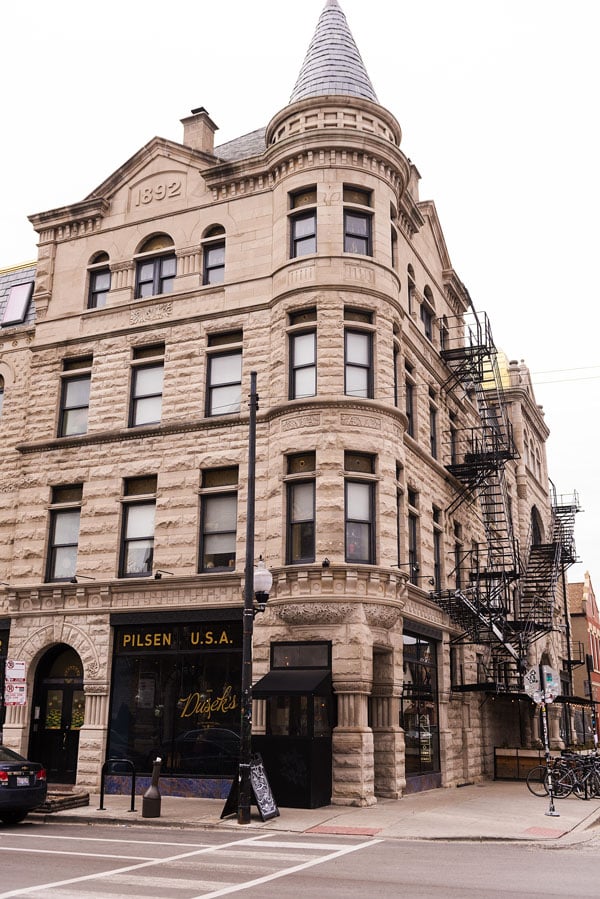
Thalia Hall, a Bohemian opera house built in 1892, still stands today. Photo by Ken Carl
The changes in Pilsen have also attracted an influx of non-Latino residents and contributed to an increase in property values and rents, fueling deep anxieties among many long-time residents. Expressions of Mexican culture have taken on a new urgency, once again becoming a political act.
But not everyone is critical of the changes. Lifelong resident Tina Hernandez says that she enjoys all of it – every medium, every artist’s work, every contribution to making Pilsen more rich, lively, and engaging.
“What’s great is the diversity,” she said, adding that Pilsen was highly segregated for many years.
“All the cultures now, and what Pilsen as a whole has to offer….It is exposing us to things that we were never exposed to,” she said.
To her, that is worth the increasing costs. She just hopes that the people who have made Pilsen what it is today will feel the same and will be able to thrive along with the neighborhood.


